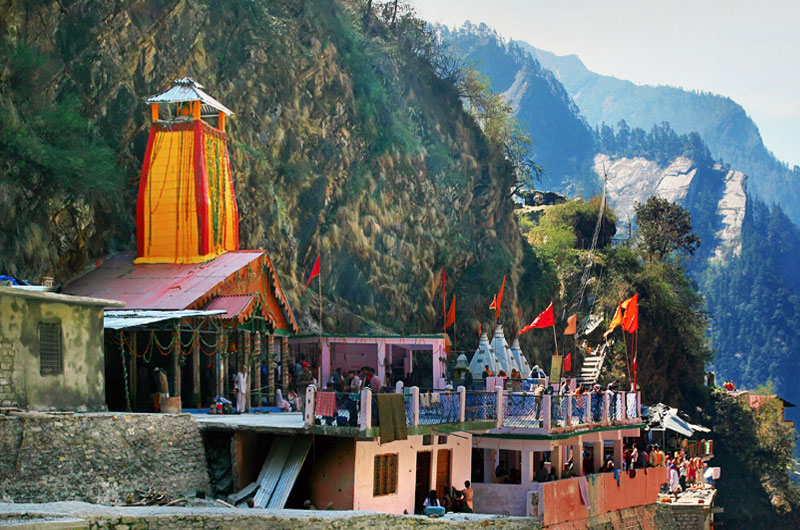
Yamunotri Temple, Uttarakhand: The Sacred Abode of the Yamuna River
Perched at an altitude of 3,293 meters (10,804 feet) in the majestic Garhwal Himalayas, the Yamunotri Temple is a revered pilgrimage destination in Uttarakhand. As one of the Char Dham sites, this sacred temple is dedicated to the goddess Yamuna, the sacred river that flows through northern India. The temple, nestled in the pristine beauty of the Himalayas, attracts thousands of devotees and nature enthusiasts each year. This comprehensive guide explores the Yamunotri Temple, detailing its history, architectural features, tourism specialty, locality, and practical information for visitors.
History of Yamunotri Temple
Ancient Origins
- Historical Significance: The Yamunotri Temple is believed to have been originally built by Maharani Guleria of the princely state of Jaipur in the 19th century. The temple has been an important pilgrimage site for centuries, long before the current structure was established.
- Legendary Roots: According to Hindu mythology, Yamunotri is the source of the Yamuna River, which is said to have been created by the goddess Yamuna. The temple is believed to be the place where she descended to bless the devotees. The sacred hot springs near the temple are also considered to be a divine gift.
Reconstruction and Renovation
- Historical Changes: The original temple structure was damaged by natural calamities over the years, including landslides and floods. The current temple was reconstructed in the early 20th century, preserving its religious significance while adapting to modern needs.
- Architectural Evolution: Despite renovations, the temple has maintained its traditional architecture and design, reflecting the regional style and religious symbolism.
Architectural and Religious Features
Temple Architecture
- Main Shrine: The Yamunotri Temple is a modest but picturesque structure made of stone and wood. The temple’s façade is adorned with traditional carvings and paintings depicting the goddess Yamuna and various Hindu deities.
- Sacred Hot Springs: The temple complex includes several natural hot springs, known as ‘kunds’, which are considered sacred. These springs are believed to have healing properties and are used for ritual ablutions.
- Divine Symbolism: The primary deity of the temple is a black marble idol of Goddess Yamuna. Devotees offer prayers and perform rituals to seek her blessings and protection.
Rituals and Practices
- Daily Rituals: The temple follows a regular schedule of rituals, including morning and evening aarti (ritual light offerings), bhajans (devotional songs), and pujas (worship ceremonies). Pilgrims participate in these rituals as part of their spiritual journey.
- Festivals: The temple hosts several major festivals throughout the year, including Yamuna Jayanti, which celebrates the birth of Goddess Yamuna. These festivals are marked by special prayers, processions, and community gatherings.
Tourism Specialty and Locality
Unique Features
- Religious Significance: The Yamunotri Temple is a key site in the Char Dham pilgrimage circuit, which includes Yamunotri, Gangotri, Kedarnath, and Badrinath. Visiting Yamunotri is considered an essential part of spiritual practice for many devotees.
- Natural Beauty: The temple’s location amidst the Himalayan peaks and lush forests offers breathtaking views and a serene environment. The surrounding landscape is ideal for trekking, nature walks, and experiencing the untouched beauty of the Himalayas.
Locality
- Location: Yamunotri is situated in the Uttarkashi district of Uttarakhand, approximately 200 kilometers from the city of Dehradun. The temple is accessible via a challenging trek from the base town of Janki Chatti.
- Accessibility: The nearest major town is Dehradun, which is well-connected by air, rail, and road. From Dehradun, visitors can travel to Janki Chatti by road and then undertake the trek to the temple. The journey requires careful planning and physical preparation due to the rugged terrain.
Best Time to Visit
Ideal Seasons
- Summer Season (May to June): The best time to visit Yamunotri is during the summer months when the weather is relatively mild and suitable for trekking. The temperature ranges from 15°C to 20°C (59°F to 68°F), making it comfortable for travel and exploration.
- Post-Monsoon (September to October): The post-monsoon period is also a good time to visit, as the weather is clear, and the trails are less slippery. This period offers a pleasant climate and fewer crowds.
Monsoon Season (July to August)
- Weather Conditions: The monsoon season brings heavy rainfall to the region, which can lead to landslides and travel disruptions. It is advisable to avoid visiting during this period due to the increased risk of natural hazards.
Nearby Tourist Spots
In Uttarkashi
- Gangotri Temple: Located about 100 kilometers from Yamunotri, the Gangotri Temple is dedicated to Goddess Ganga and is another key site in the Char Dham pilgrimage. The temple is situated at the source of the Ganges River, amidst breathtaking Himalayan scenery.
- Harshil: Approximately 50 kilometers from Yamunotri, Harshil is a picturesque village known for its scenic beauty and tranquil environment. It offers opportunities for nature walks, photography, and relaxation.
Nearby Attractions
- Tungnath Temple: Situated around 200 kilometers from Yamunotri, Tungnath Temple is one of the Panch Kedars and is renowned for its ancient architecture and panoramic views of the Himalayan peaks. It is accessible via a trek from Chopta.
- Barkot: About 40 kilometers from Yamunotri, Barkot is a scenic town known for its natural beauty and tranquil environment. It serves as a base for visitors traveling to Yamunotri and offers various trekking and sightseeing options.
Best Places to Eat
Local Dining Options
- Hotel Yamunotri: Located in Janki Chatti, Hotel Yamunotri offers simple and traditional meals suitable for pilgrims and travelers. The restaurant serves vegetarian food, including local delicacies and staple dishes.
- Bhandari Restaurant: Situated in Barkot, Bhandari Restaurant provides a range of vegetarian options, including Indian and regional cuisine. It is a convenient choice for travelers en route to Yamunotri.
Nearby Restaurants
- The Buffet: Located in Dehradun, The Buffet offers a diverse range of cuisines, including Indian, Chinese, and continental dishes. It is a popular choice for travelers seeking a comfortable dining experience before or after their journey to Yamunotri.
- Kashi Nath: Situated in Dehradun, Kashi Nath is known for its traditional North Indian meals and snacks. It provides a range of vegetarian options and is a good spot for a hearty meal.
Hotels Near Yamunotri Temple
Luxury Hotels
- Hotel Prakriti: Located in Janki Chatti, Hotel Prakriti offers comfortable accommodations with modern amenities. It is well-suited for pilgrims and travelers seeking a relaxing stay before embarking on the trek to the temple.
- Hotel GMVN: Managed by the Garhwal Mandal Vikas Nigam, this hotel in Janki Chatti provides basic amenities and comfortable lodging for visitors. It is known for its clean rooms and helpful staff.
Budget Hotels
- Hotel Shree Ram: Situated in Janki Chatti, Hotel Shree Ram offers affordable lodging with essential facilities. It is a convenient option for budget-conscious travelers and pilgrims.
- Hotel Suresh: Located in the vicinity of Janki Chatti, Hotel Suresh provides basic accommodations and is popular among budget travelers. It offers a simple and cost-effective stay for those visiting Yamunotri.
Pilgrimage and Visitor Experience
Preparing for the Journey
- Trek Preparation: The trek from Janki Chatti to Yamunotri is approximately 5 kilometers (3 miles) and can be challenging due to the steep and rugged terrain. Visitors are advised to be physically prepared, carry adequate clothing, and stay hydrated.
- Permits and Entry: No special permits are required to visit the Yamunotri Temple, but travelers should check for any local regulations or restrictions before their journey. It is advisable to follow local guidelines and respect the temple’s customs.
Exploring the Temple
- Temple Tour: Guided tours of the temple and surrounding areas can enhance the visitor experience by providing historical and cultural insights. Guides are available to explain the significance of various features and practices.
- Souvenirs and Shopping: The area around the temple has small shops selling religious artifacts, souvenirs, and local handicrafts. Visitors can explore these shops to purchase mementos of their pilgrimage.
Conclusion
The Yamunotri Temple stands as a beacon of spiritual significance and natural beauty amidst the rugged terrains of the Garhwal Himalayas. Its historical roots, architectural charm, and sacred hot springs make it a unique and compelling destination for pilgrims and travelers alike. Whether you are seeking spiritual solace, adventure, or simply a chance to witness the stunning Himalayan landscape, a visit to Yamunotri promises a memorable and enriching experience.
